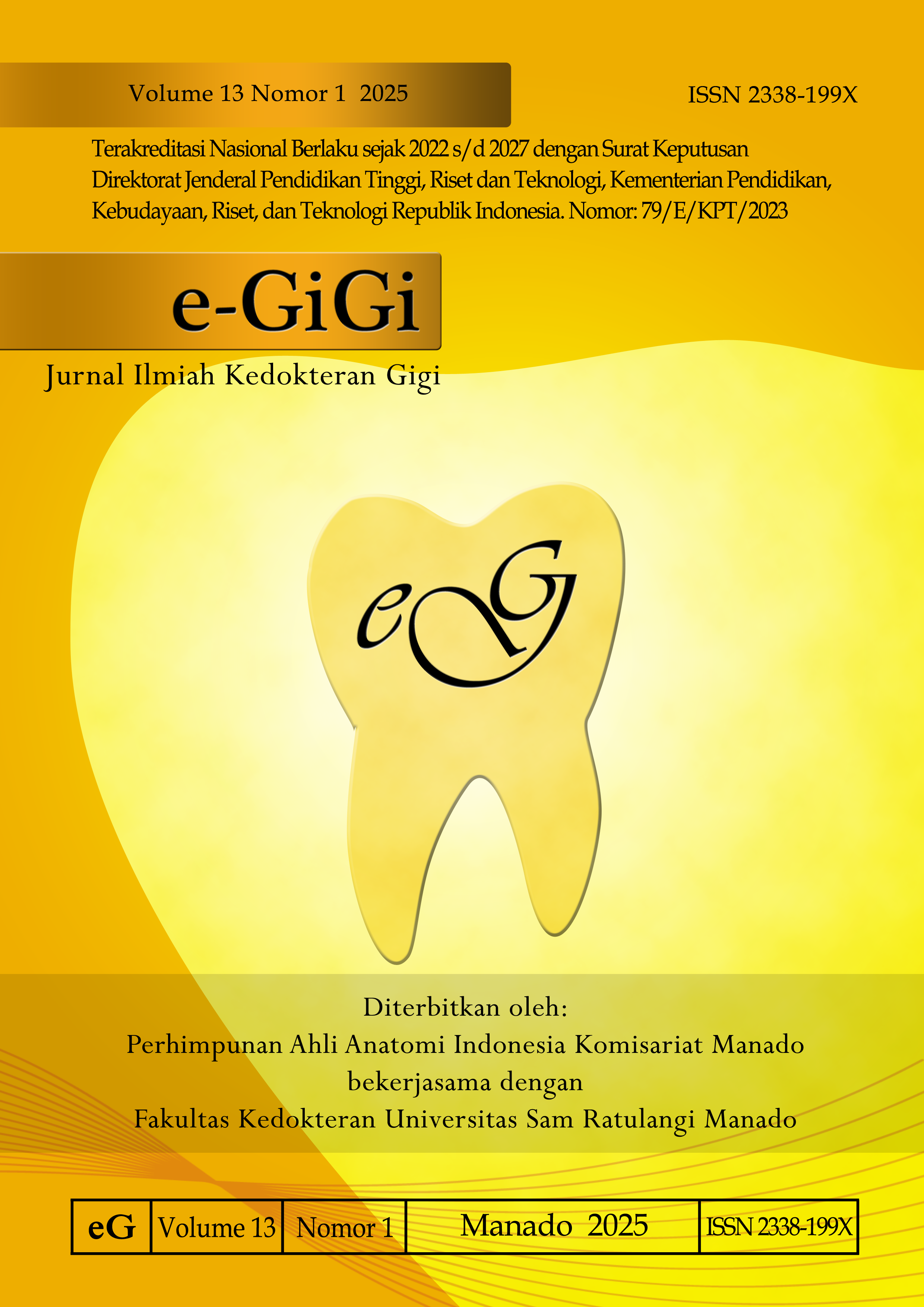Pengaruh Berkumur Air Kelapa (Cocos nucifera) terhadap Laju Aliran Saliva
DOI:
https://doi.org/10.35790/eg.v13i1.51499Abstract
Abstract: Decreased salivary flow rate can be caused by many things, inter alia age, consumption of certain drugs, and psychological effects. The benefits of coconut water have been widely studied, one of which is related to dental and oral health. However, there are still not many studies about the effects of various varieties of coconut water in increasing the flow rate of saliva, especially old coconut water which is often thrown away as waste. This study aimed to determine whether there was an effect of coconut water (Cocos nucifera) gargling on the rate of salivary flow. This was an experimental and analytical study with a quasi-experimental design, and pre-test and post-test control group design approaches. Samples were dentistry undergraduate students of Universitas Sam Ratulangi taken by simple random sampling. Samples were divided into two groups: treatment group (gargling with old coconut water) and control group (gargling with mineral water). The results showed that in the treatment group, there was an increase of salivary flow rate from 0.7114 to 1.1248 after gargling with old coconut water. Meanwhile, in the control group, there was an increase of salivary flow rate from 0.7962 to 0,8495 after gargling with mineral water. Since research data were normally distributed and homogenous, the statistical analysis was continued with the unpaired T-test which obtained a p-value of <0.001 (p<0.05). In conclusion, coconut water (Cocos nucifera) gargling can influence the salivary flow rate.
Keywords: coconut water; salivary flow rate; gargling
Abstrak: Laju aliran saliva yang menurun dapat diakibatkan oleh berbagai hal antara lain faktor usia, mengonsumsi obat-obatan tertentu, dan efek psikis. Manfaat air kelapa terhadap kesehatan antara lain kesehatan gigi dan mulut telah diteliti namun belum banyak penelitian mengenai efek air kelapa dari berbagai varietas dalam hal meningkatkan laju aliran saliva terutama air kelapa tua yang masih sering dibuang sebagai limbah. Penelitian ini bertujuan untuk mengetahui pengaruh berkumur air kelapa (Cocos nucifera) terhadap laju aliran saliva. Jenis penelitian ialah eksperimental dengan rancangan quasi eksperimental, dan pendekatan pre test dan post test control group design. Sampel penelitian ialah mahasiswa S1 PSPDG Fakultas Kedokteran Universitas Sam Ratulangi yang diambil secara simple random sampling dan dibagi atas dua kelompok, yaitu kelompok perlakuan (berkumur air kelapa tua) dan kelompok kontrol (berkumur air mineral). Hasil penelitian mendapatkan pada kelompok perlakuan rerata laju aliran saliva sebelum dan setelah berkumur air kelapa naik dari 0,7114 menjadi 1,1248 sedangkan pada kelompok kontrol rerata laju aliran saliva sebelum dan setelah berkumur air mineral naik dari 0,7962 menjadi 0,8495. Oleh karena data penelitian berdistribusi normal dan homogen, dilanjutkan dengan uji t tidak berpasangan yang mendapatkan nilai p<0,001 (p<0,05). Simpulan penelitian ini ialah berkumur air kelapa (Cocos nucifera) dapat meningkatkan laju aliran saliva.
Kata kunci: air kelapa; laju aliran saliva; berkumur
References
Aminarti S, Ajizah A, Kaspul K. Pelatihan pembuatan nata de coco kepada siswa SMA Negeri 1 Jorong. Bubungan tinggi. Jurnal Pengabdian Masyarakat. 2020;1(2):66-72. Doi: https://doi.org/10.20527/ btjpm.v1i2.1786
Produksi kelapa menurut provinsi di Indonesia tahun 2017–2021 [Internet]. 2021 [cited 2022 Oct 18]. Available from: https://www.pertanian.go.id/home/index.php?show=repo&fileNum=215
Nurdyansyah F, Widyastuti DA. Pengolahan limbah air kelapa menjadi nata de coco oleh ibu kelompok tani di Kabupaten Kudus. Jurnal Kewirausahaan dan Bisnis. 2017;21(11):22-30. Doi: https://doi.org/10.20961/jkb.v21i11.20900
Putri T. Keampuhan air dan minyak kelapa bagi kesehatan. Yogyakarta: Laksana; 2019.
Riyani C. Pengolahan nata de coco menggunakan skim dan air kelapa tanpa nitrogen tambahan. Al-Ulum: Jurnal Sains dan Teknologi. 2020;6(1):7-11. Doi: http://dx.doi.org/10.31602/ajst.v6i1.3656
Andayani R, Noviyandri PR, Husna A. The effect of gargling old coconut water (Cocos nucifera L.) on the salivary flow rate and pH in students of SMAN 10 Fajar Harapan Banda Aceh. In: 1st Aceh International Dental Meeting (AIDEM 2019), Oral Health International Conference on Art, Nature and Material Science Development 2019. Paris: Atlantis Press; 2021. p: 76-80. Doi: 10.2991/ahsr.k.210201.017
Lewapadang W, Tendean LEN, Anindita PS. Pengaruh mengonsumsi nanas (Ananas comosus) terhadap laju aliran saliva pada lansia penderita xerostomia. e-GiGi. 2015;3(2):454-8. Doi: https://doi.org/10.35790/eg.3.2.2015.9837
Arsyad, Syamson MM. Analisis xerostomia terhadap kesehatan gigi dan mulut terkait kualitas hidup pada lansia di Desa Mattombong Kecamatan Mattiro Sempe Kabupaten Pinrang. Media Kesehatan Gigi. 2019;18(1):75-82. Doi: 10.32382/mkg.v18i1.1034
Rawung F, Wuisan J, Leman MA. Pengaruh obat kumur beralkohol terhadap laju aliran saliva dan pH saliva. e-GiGi. 2017;5(2):125-9. Doi: https://doi.org/10.35790/eg.5.2.2017.16538
Andriany P, Hakim RF, Mahlianur. Pengaruh konsumsi kopi Ulee Kareng (Arabika) terhadap pH saliva pada usia dewasa muda. Dentika. 2012;17(2):150-22. Doi: https://doi.org/10.32734/dentika.v17i2.1769
Downloads
Published
How to Cite
Issue
Section
License
Copyright (c) 2024 Vonny N. S. Wowor, Ni Wayan Mariati, Richard F. Depthios

This work is licensed under a Creative Commons Attribution-NonCommercial 4.0 International License.
COPYRIGHT
Authors who publish with this journal agree to the following terms:
Authors hold their copyright and grant this journal the privilege of first publication, with the work simultaneously licensed under a Creative Commons Attribution License that permits others to impart the work with an acknowledgment of the work's origin and initial publication by this journal.
Authors can enter into separate or additional contractual arrangements for the non-exclusive distribution of the journal's published version of the work (for example, post it to an institutional repository or publish it in a book), with an acknowledgment of its underlying publication in this journal.
Authors are permitted and encouraged to post their work online (for example, in institutional repositories or on their website) as it can lead to productive exchanges, as well as earlier and greater citation of the published work (See The Effect of Open Access).






